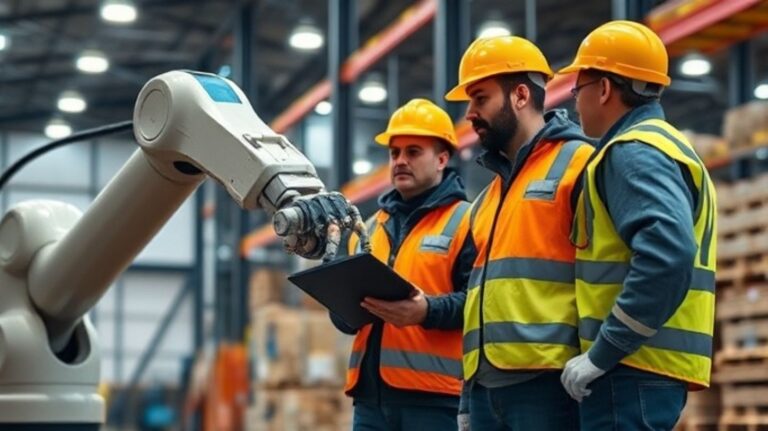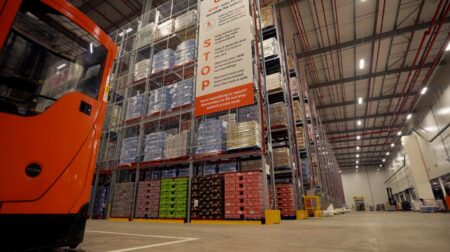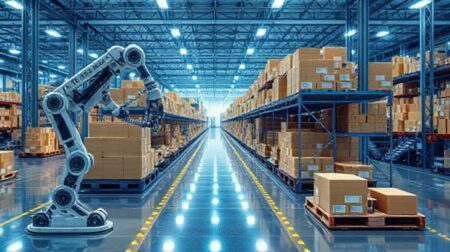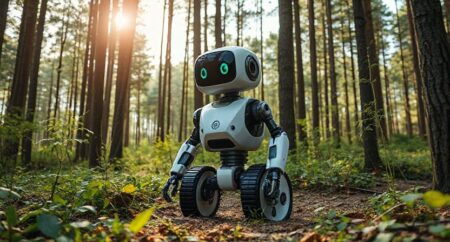Robotics & Automation Magazine discovers how advanced sensors and data-collection technologies are unlocking proactive approaches to workplace safety and improved monitoring of staff wellbeing…
In an era defined by rapid technological advancement, businesses are leveraging data to drive proactive, prevention-based approaches to workplace health and safety.
Digital technologies, from advanced sensors to artificial intelligence (AI) and machine learning, are enabling companies to gather and analyse unprecedented amounts of data on facility operations, moving them away from reactive measures.
These tools are reshaping how health and safety departments operate, transforming time consuming manual tasks into streamlined, data-driven processes. Automation’s reach extends to taking over dirty and dangerous work, minimising risks for human employees. Today, automation is creating safer workplaces and driving operational efficiency, with financial incentives that include improved employee retention, lower insurance premiums, and reduced legal risks.
Industry 4.0 technologies have become the backbone of modern manufacturing, warehousing and supply chain processes, reshaping how businesses approach equipment maintenance and worker safety. Through a combination of Internet of Things (IoT) devices, AI, and machine learning, automation now supports continuous equipment monitoring, allowing companies to gather real-time data on machinery performance and facility conditions.
Theresa Macdonald, business development manager at Element Logic, explains how the IoT is revolutionising workplace safety: “Businesses are now harnessing IoT to monitor everything from air quality to worker activity in real-time. This constant data stream allows us to maintain a safe and comfortable work environment.” In the demanding environment of a warehouse, wearable technologies can track workers’ vital signs, alerting supervisors to issues such as overexertion or heat stress, allowing for interventions before serious problems occur.
Macdonald highlights predictive maintenance as a transformative innovation enabled by AI and machine learning. “Systems can now anticipate equipment failures before they happen, allowing us to address health and safety issues proactively rather than reactively.” This approach, she says, relies on strategically placed sensors that create an early warning system, helping to prevent accidents, minimise downtime, and ensure operational continuity. Predictive maintenance reduces unexpected failures, providing cost savings on emergency repairs and fostering a safer workplace by reducing the need for urgent, high risk interventions.
Moreover, predictive analytics enable companies to create long-term maintenance schedules that align with operational demands, balancing productivity with preventive care. This not only optimises equipment usage but also enhances employee safety by minimising the risks associated with equipment breakdowns during peak times. By adopting these advanced maintenance strategies, companies can safeguard both their assets and their workforce.
Reduced exposure
The concept of a ‘hierarchy of control’ underpins risk management in industries with hazardous environments, aiming to systematically reduce workers’ exposure to potential dangers. This hierarchy, as Op-Tec describes, starts with eliminating hazards and progresses down to relying on personal protective equipment (PPE) as a last resort. In scenarios where elimination or substitution is difficult, automation acts as an engineering control, offering a cost-effective alternative for risk reduction.
For example, remote work technology allows employees to control and monitor dangerous processes from a safe distance, effectively removing them from physical hazards. This has clear applications in sectors such as mining, manufacturing, and chemical processing, where exposure to harmful materials or unstable environments poses serious risks. Additionally, by automating repetitive or physically demanding tasks, companies reduce the risk of human error, which can lead to workplace accidents.
Paul Larking, global robotics and automation senior application engineering specialist, abrasive systems division R&D at 3M, underscores automation’s role in shielding workers from hazardous environments without compromising operational efficiency. “Automation reduces workers’ exposure to dangerous dust, noise, and direct contact with hazardous materials,” he says. “It also eliminates the need for workers to handle sharp tools or hot surfaces, lowering the risk of cuts, burns, and fatigue.” Emergency stops, machine guards and embedded sensors serve as additional safety measures, preventing accidents resulting from human error.
In high-risk industries, the benefits of automation extend beyond immediate physical safety. By taking on monotonous, repetitive tasks, automated systems help reduce the cognitive load on employees, mitigating issues such as mental fatigue, which is known to contribute to accidents. As businesses consider implementing these technologies, the advantages of automation in reducing both physical and psychological risk factors are becoming increasingly apparent.
Safety culture
Despite automation’s numerous advantages, the successful integration of technology into health and safety strategies requires a human-centred approach. While automated systems offer substantial safety improvements, human oversight and engagement remain critical to ensuring these systems are used effectively and ethically.
Macdonald emphasises the importance of cultivating a safety culture that places people at its core, with open lines of communication and continuous training. “A common misconception is that automation alone can solve all safety problems,” she says. “In reality, it should be integrated into a broader safety strategy that includes training, maintenance, and risk evaluation.” Automation thus cannot replace human intuition and adaptability, especially in dynamic environments. Instead, it should be seen as a tool to support a holistic safety framework.
Building a workforce that feels comfortable with automated systems requires thoughtful change management and regular skills training. According to Larking, “Employees need to understand the capabilities and limitations of these technologies to work alongside them effectively.” This proactive approach helps prevent scenarios where workers may misuse or mistrust automated systems, potentially compromising safety.
“Automation reduces workers’ exposure to dangerous dust, noise, and direct contact with hazardous materials. It also eliminates the need for workers to handle sharp tools or hot surfaces, lowering the risk of cuts, burns, and fatigue” – Paul Larking, global robotics and automation senior application engineering specialist, abrasive systems division R&D, 3M
In addition to training, companies should consider the mental and emotional impact of automation on their employees. Introducing robots and automated systems can raise concerns about job security or alter workplace dynamics. By involving employees in the process and emphasising how these changes improve safety and productivity, companies can foster a more positive reception of automation technologies.
Key innovations
Automation’s potential extends beyond simply replacing manual labour; it drives strategic shifts in how companies approach health and safety. Collaborative robots, or cobots, are a leading example of this change, designed to work safely alongside humans without the need for heavy guarding. Equipped with advanced sensors, cobots detect human presence and slow down or stop to prevent accidents, making them ideal for shared workspaces.
Larking identifies machine vision systems as another valuable tool in automation-driven safety strategies. “Machine vision uses cameras and image-processing algorithms to inspect, monitor, and guide robotic operations,” he explains. “This technology helps maintain high standards of product quality while also identifying potential safety issues, such as misaligned parts or foreign objects, before they impact operations.”
Augmented reality (AR) and virtual reality (VR) are increasingly being integrated into safety training programmes, providing immersive environments for workers to practice procedures without real-world risk. Larking points out that AR can deliver “real-time information and guidance”, reducing errors during complex tasks. By training staff in simulated settings, companies can improve preparedness and ensure workers are well equipped to handle real-life scenarios.
AI and machine learning also play crucial roles, not only by optimising operations but by predicting and preventing hazards. Through analysing vast amounts of historical and real time data, these technologies identify patterns and suggest preventive actions, enhancing the overall safety framework. Remote monitoring systems and exoskeletons, wearable devices that support human movement, provide additional layers of protection for workers engaged in physically demanding tasks. These devices offer mechanical assistance, reduce strain, and improve endurance, enhancing employee health and productivity.
Audits and updates
Automation technologies are only effective when they are continually updated and regularly audited. In rapidly changing industries, systems that are considered cutting-edge today can quickly become obsolete. Macdonald stresses the importance of routine evaluations: “Technology evolves quickly, and what’s state-of-the-art today may be outdated tomorrow. Regular assessments ensure that safety protocols and systems remain effective.”
Cybersecurity is another critical area that requires vigilance. As operations become more digitised and interconnected, they also become more vulnerable to cyber threats. A security breach can compromise automated systems, putting workers at risk if machinery malfunctions or fails due to external interference. Regular cybersecurity audits help organisations identify vulnerabilities, assess compliance, and implement measures to protect both data and physical systems from breaches. Addressing these concerns protects the integrity of automated processes and secures the safety of workers who rely on them.
Smart stacks, healthy backs
Palletising – the process of stacking and organising products or goods onto pallets for efficient handling, storage, and transportation – can be performed manually or through automation. Automated palletising optimises space, stabilises loads and streamlines logistics processes, making it an integral step in supply chain and warehousing operations. It is also essential for large-scale production, where maximising load stability is key to preventing damage and maintaining efficiency. However, manual palletising presents significant health risks, including musculoskeletal issues due to the repetitive and strenuous nature of the task.These risks can limit the participation of senior workers and contribute to long-term injuries. Irving Paz Chagoya, global industry segment leader for palletising and packaging at Universal Robots, shares an example: “Before automating its palletising, one company we worked with estimated that over an eight-hour shift, each worker was lifting 8,000kg of product, presenting a danger to body and posture.” Chagoya highlights that automation can alleviate these health risks, reduce monotony and improve overall employee well-being.
By automating palletising, workers can protect their health and focus on more complex tasks better suited to their skills, such as quality assurance. In fact, the use of robotics in palletising and heavy lifting tasks has been shown to reduce musculoskeletal disorders among workers by over 40%, according to a study by the National Institute for Occupational Safety and Health. Palletising applications can often represent a logistical bottleneck, hindering operational growth. Automating these processes increases capacity, boosts workplace safety, and enables production to scale to meet demand – all while protecting employee safety
and wellbeing.
Macdonald also points to scalability as an essential consideration for businesses undergoing growth or operational changes. “By investing in systems that can adapt and scale, companies can avoid future complications as their needs evolve.” This flexibility ensures that safety remains a top priority even as businesses expand or adopt new technologies.
Well audited automation also enhances precision and consistency, qualities crucial in tasks that require high accuracy, such as pharmaceutical quality control or precision manufacturing in electronics. Automation’s consistency reduces the likelihood of human error, which can lead to costly mistakes or compromised safety.
Macdonald notes that “one of the biggest advantages of automation in health and safety applications is reliability”. Automated systems, unlike human workers, are not subject to fatigue or distraction. “They always follow safety protocols to the letter,” she adds, “which significantly reduces the risk of accidents caused by human error.” This consistency ensures that safety standards are upheld continuously, contributing to safer and more efficient operations.
Drawbacks and limitations
And yet, automation still presents some challenges and limitations in the context of health and safety. One significant risk is over-reliance on technology, which can lead to reduced human situational awareness and the erosion of specific skills. The Safe and Healthy Work in the Digital Age 2023-2025 report, published by the European Agency for Safety and Health at Work, warns that “using digital technologies to automate tasks brings risks, including over-reliance on systems and loss of situational awareness”.
Larking notes that the upfront costs and maintenance requirements of automated systems can also be substantial. “High-precision equipment and robotics often demand significant investment, both in initial setup and ongoing maintenance,” he says. Additionally, integrating automation into existing processes can involve complex programming, extensive setup, and longer calibration times. Companies need to carefully evaluate these costs and logistical considerations before deciding to adopt automation.
The report’s recommendations include involving developers early in the automation planning process, ensuring digital literacy across the workforce, adopting a human-centred approach, and providing equal access to information. These measures can help mitigate the risks associated with automation, ensuring that it complements human capabilities rather than replacing them outright.
As Larking concludes, innovations in automation for health and safety are transforming the workplace by redefining human-machine interactions. By harnessing this technology thoughtfully, industries can enhance efficiency, reduce risks, and pave the way for safer, more resilient workplaces. With the right balance of human oversight, continuous training, and adaptive safety protocols, automation offers a future where technology supports – not replaces – the human workforce
This article originally appeared in the November 2024 issue of Robotics & Automation Magazine






